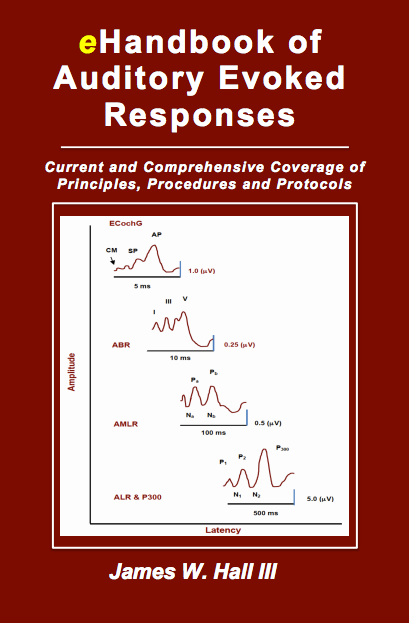eHandbook of Auditory Evoked Responses - New Resource for Audiologists
Carolyn Smaka: Congratulations on publication of the eHandbook of Auditory Evoked Responses. Tell me about your original handbook for auditory evoked responses – when was it written and what was the reception?

Dr. Jay Hall: It’s hard to believe that the original Handbook of Auditory Evoked Responses was published in 1992, 25 years ago. Jim Jerger had invited me to write, on very short notice, an ABR chapter for one book in a little two-book series he was editing for the now-defunct College Hill Press. My chapter ended up quite lengthy, and it included well-over 100 references. A few months after completing the manuscript, publisher Sadanand Singh called me to ask if I would be interested in writing a book on the topic. I readily agreed to prepare the manuscript for a book covering all major auditory evoked responses. I started working on the Handbook when our daughter was born in 1986 and the 871 page tome was finally published in 1992 when she was in the first grade! Unfortunately, the original publishing company was sold during the time I was laboring on the manuscript and publication was delayed for over 2 years as other publishers acquired and then sold my manuscript, along with those for other disgruntled audiology authors.
Nonetheless, the original Handbook was a big hit within the audiology community in the USA and around the world. Students and practicing audiologists often referred to it as their “bible” for information on auditory evoked responses. After a 15-year successful run, the book was clearly in need of an update. In 2006, I finally convinced the publisher to come out with another version that I titled the New Handbook of Auditory Evoked Responses.
Carolyn: What has changed since the first book was published, in terms of equipment, protocols, measures, etc.?
Jay: Each of the first two Handbooks included practical reviews and discussions of state-of-the-art techniques for measurement and analysis of auditory evoked responses applied clinically in audiology. Thousands of articles appear annually describing research findings on responses such as ABR, ASSR, ECochG, and cortical auditory evoked responses. My overall objective in writing the books was to compile and summarize this vast amount of information into a relatively concise text that audiology students and practicing clinicians would easily understand and apply with patients.
With dramatic advances in computer technology underlying the equipment for measurement of auditory evoked responses, there was always plenty of new material to write about, and new or improved clinical applications to describe for practicing audiologists.
The latest publication is the eHandbook of Auditory Evoked Responses, and it was published in August 2015. It is not just another version of earlier books. It is an entirely reorganized, rewritten, and up-to-date review of auditory evoked responses. With a length of over 1000 pages, I guess the eHandbook of Auditory Evoked Responses doesn’t fit the definition of “relatively concise”, but it is certainly comprehensive in scope.
Carolyn: Who is the intended reader for the eHandbook - audiology students as well as experienced clinicians? What can each expect to take away from the book?
Jay: I wrote the eHandbook for the same readership as the earlier Handbooks, that is, graduate students in audiology and audiologists who apply auditory evoked responses in their clinical practice. The book is also a valuable resource for hearing scientists and other non-clinicians who are interested in auditory neurophysiology. The eHandbook includes background information and a review of the principles underlying all major auditory evoked responses, as well as a description of why and how each auditory evoked response is recorded in various patient populations.
One unique feature of the eHandbook is a chapter entitled “Meet the Manufacturers.” Chapter 13 includes informative contributions from each of the manufacturers of auditory evoked response systems.
Carolyn: Why did you decide to publish the book in a digital eBook format rather than a print format?
Jay: There are multiple reasons for my decision to publish an eBook, rather than a traditional hard-copy version. I’ll just cite a few of the reasons here. Others are included in the Preface to the eHandbook. Modest pricing is one of the major advantages of going digital. Costs of printing, storing, and shipping heavy hard-copy books drive the average price up to well over $100. An eBook is easily priced much lower.
And, eBooks are more portable and accessible. For example, it’s possible to download the eHandbook to more than one electronic device, such as a laptop, tablet, smart phone, or even an auditory evoked response computer. Digital publications can be readily purchased and immediately downloaded from most countries in the world, without the delays associated with shipping a hard-copy book internationally. Other positive features of eBooks include color photographs and the ability to locate information quickly with a search of the table of contents.
Carolyn: What kinds of things do you envision we'll be doing with auditory evoked responses ten years from now - where is the future of this area headed?
Jay: The best way to predict where clinical audiology is going in the future is to follow current research. Not all laboratory research leads to clinical applications, of course, but there are several clear research trends that have already or will soon be applied with patients. One is the use of sophisticated stimuli such as chirps for measurement of the ABR and ASSR. Chirp stimuli more effectively activate the cochlea. There are chirp versions of clicks and tone burst. Chirp-evoked ABRs have amplitudes that are considerably bigger than the amplitudes for conventional stimuli resulting in much shorter test time, more confident detection of the response, and sometimes even more accurate threshold estimations. ABR or ASSR test time may actually be so short with chirp stimulation that sedation is not required for most young children.
Another clear trend is an increase in clinical application of cortical auditory evoked response measurement, particularly for two patient populations. One type of patient is an infant with hearing loss who requires amplification or cochlear implantation. Cortical auditory evoked responses can be applied to verify benefit from management before behavioral audiometry can be performed. Another application is objective verification of central auditory nervous system status in children with auditory processing disorder and adults with various CNS dysfunction, such as cognitive decline or traumatic brain injury.
The kind of information included in the eHandbook of Auditory Evoked Responses is rapidly expanding, and includes detailed reviews of these and many other trends. New research is constantly being described in peer-reviewed journals, along with new or improved clinical applications of auditory evoked responses. One major advantage of an eBook is the ability to publish updated versions of textbooks almost at a moments notice. I can assure you that the eHandbook of Auditory Evoked Responses will not become outdated.
Carolyn: Thanks for your time today, Jay. We're excited to see this new resource added to your long list of contributions to education and continuing education in audiology, and we wish you all the best with it. The eHandbook of Auditory Evoked Responses is available now on Amazon.com.



